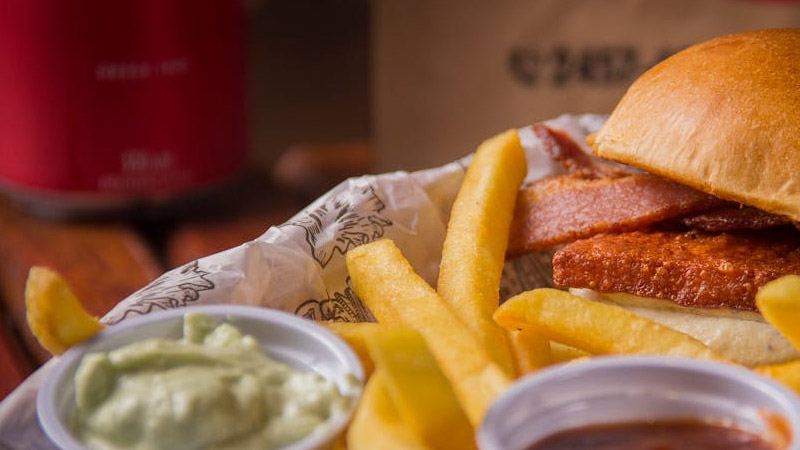How to Guide Users Deeper Through Thoughtful Above-the-Fold Web Design?
2021 / 09 / 30
The above-the-fold area is the "first visual" section users see upon initially visiting a website without scrolling. Consequently, the quality of its design is a critical factor in determining whether they stay to explore further or leave immediately. So, how can meticulous web design make this area not only eye-catching but also effective in guiding users deeper into the site?
The term "Above the Fold" originates from the newspaper era, referring to the front-page content visible above the fold, designed to attract buyers. In web design, it denotes the first visual area users encounter upon entering a website without needing to scroll. This space forms the user's first impression of the site, shaping their initial perception of the brand, product, or service.
With the diversification of end devices, the specific dimensions of the above-the-fold area vary by device. From desktop computers to tablets and mobile phones, each screen has different resolutions and aspect ratios, making responsive web design fundamental for ensuring the complete presentation of above-the-fold content.

The importance of the above-the-fold area can be understood from both psychological and user behavior perspectives. The psychological "Primacy Effect" indicates that first impressions significantly influence subsequent cognition and judgment. This effect is even more pronounced in the digital environment: research shows that the design of a website's above-the-fold section can form a user's initial brand impression in less than 0.05 seconds.
Furthermore, user behavior data reveals that if the above-the-fold area fails to deliver value quickly, over half of the users will choose to leave. This means the above-the-fold section is not just a visual facade but a strategic point for retaining users and reducing bounce rates. A successful above-the-fold design effectively guides users to complete desired actions, whether it's browsing content, filling out a form, or making a purchase.
How to Guide Users Deeper Through Thoughtful Above-the-Fold Web Design?
Technique 1: Create a Unique and Immersive Visual Experience
The visual design of the above-the-fold area is the primary magnet for user attention. To capture users instantly, designers should prioritize using high-quality, large-scale visual elements, such as high-definition photographs, original illustrations, or background videos. These elements not only convey brand tone but also create an immersive experience, making users feel the website's uniqueness.
For instance, a travel website can use a full-screen dynamic landscape video on the above-the-fold section to immediately evoke a sense of exploration, while an art brand can showcase its creative style through original illustrations. The key is that these visual elements must be closely tied to the brand core, avoiding genericness.
Simultaneously, responsive design plays a crucial role here. Regardless of the device used, the above-the-fold content should be displayed completely, preventing element misalignment or slow loading times that could harm the user experience.
Technique 2: Design an Intuitive and User-Friendly Navigation System
Navigation is the signpost of a website, and the navigation design within the above-the-fold area is critical in determining whether users can explore the site smoothly. With the prevalence of mobile devices, the hamburger menu (☰) has become a common design choice, but its implementation requires careful consideration.
An excellent navigation design should possess the following characteristics:
● Clear icon placement, typically in the top-right or top-left corner.
● A clear and readable menu upon clicking.
● Inclusion of key pages users most frequently seek.
● A consistent experience across desktop and mobile devices.
It is important to note that navigation should not be oversimplified to the point of being difficult to use, nor should it be completely hidden, leaving users lost. Balancing aesthetics and functionality is the core challenge of navigation design.
Technique 3: Establish Relevance with Users Through Content
While the above-the-fold area is primarily visual, textual content is equally indispensable. The text here must be concise and powerful, instantly communicating the website's core value. For example, a brand slogan or value proposition should directly state the solution the website offers.
Furthermore, the relevance between imagery and text is crucial. Visual elements and textual messages should complement each other, collectively telling a coherent story. For instance, an eco-friendly brand's website might use natural imagery paired with a slogan like "Do Your Part for the Planet," reinforcing the brand positioning.
Technique 4: Guide Users to Complete Key Actions
The above-the-fold area is not just a display window but also the starting point for Calls-to-Action (CTAs). Designers should skillfully incorporate guiding elements in the above-the-fold section, encouraging users to take the next step, whether it's "Learn More," "Buy Now," or "Sign Up."
Effective CTA design requires attention to:
● Button color that contrasts with the background for easy identification.
● Specific and clear text that explains the action's value.
● A prominent yet non-intrusive position.
● A clear articulation of user benefits.
For example, an e-commerce website might place a "Limited Time Offer" CTA in the above-the-fold section, simultaneously stating the discount to increase click-through intention.
Technique 5: Strengthen Brand Identity and Trust
For lesser-known brands, the above-the-fold area is a crucial opportunity to build trust. Displaying the brand logo, colors, and style enables users to quickly identify the brand and fosters a sense of familiarity.
The integration of brand elements should feel natural and not forced:
● Fixed logo position, typically in the top-left corner.
● Use of brand standard colors and fonts.
● Visual style consistent with the brand tone.
● Inclusion of trust badges (e.g., security certifications) when necessary.
Even for well-known brands, maintaining consistent brand imagery reinforces user familiarity and enhances the overall experience.
Technique 6: Focus on the Core and Minimize Distractions
A common design mistake is attempting to cram too much information into the limited space. The above-the-fold area should remain clean and focused on a single primary message or action, preventing users from feeling overwhelmed.
If multiple messages indeed need to be conveyed, consider the following strategies:
● Use a Carousel to display different key points in an organized manner.
● Guide the visual flow through a clear Visual Hierarchy.
● Incorporate ample white space to improve content readability.
Remember, simplicity does not equate to being simplistic. A well-designed above-the-fold section strikes a balance between minimalism and informational richness.
Conclusion
As a strategic focal point of a website, the design of the above-the-fold area requires a synthesis of visual aesthetics, user psychology, and technical implementation. From creating unique visuals to designing intuitive navigation, from content relevance to action guidance, every aspect demands careful planning. Technologies like responsive design and scroll-triggered animations can further create a smooth and seamless browsing experience for users.
Our web design team specializes in creating experiences that blend beauty and functionality. Through in-depth user research and data analysis, we tailor solutions for each brand. From visual strategy to technical implementation, we accompany our clients every step of the way, ensuring the website not only captures attention but also drives substantial growth.
Make your website stand out from the very first glance – Arachne Group Limited, the web design partner you deserve!
Contact Us
Phone: 852-3749 9734
Email: info@hkweb.com.hk
Website: https://hkweb.com.hk
What is the Above-the-Fold Area?
The term "Above the Fold" originates from the newspaper era, referring to the front-page content visible above the fold, designed to attract buyers. In web design, it denotes the first visual area users encounter upon entering a website without needing to scroll. This space forms the user's first impression of the site, shaping their initial perception of the brand, product, or service.
With the diversification of end devices, the specific dimensions of the above-the-fold area vary by device. From desktop computers to tablets and mobile phones, each screen has different resolutions and aspect ratios, making responsive web design fundamental for ensuring the complete presentation of above-the-fold content.
Why is the Above-the-Fold Area So Crucial in Web Design?

The importance of the above-the-fold area can be understood from both psychological and user behavior perspectives. The psychological "Primacy Effect" indicates that first impressions significantly influence subsequent cognition and judgment. This effect is even more pronounced in the digital environment: research shows that the design of a website's above-the-fold section can form a user's initial brand impression in less than 0.05 seconds.
Furthermore, user behavior data reveals that if the above-the-fold area fails to deliver value quickly, over half of the users will choose to leave. This means the above-the-fold section is not just a visual facade but a strategic point for retaining users and reducing bounce rates. A successful above-the-fold design effectively guides users to complete desired actions, whether it's browsing content, filling out a form, or making a purchase.
How to Guide Users Deeper Through Thoughtful Above-the-Fold Web Design?

Technique 1: Create a Unique and Immersive Visual ExperienceThe visual design of the above-the-fold area is the primary magnet for user attention. To capture users instantly, designers should prioritize using high-quality, large-scale visual elements, such as high-definition photographs, original illustrations, or background videos. These elements not only convey brand tone but also create an immersive experience, making users feel the website's uniqueness.
For instance, a travel website can use a full-screen dynamic landscape video on the above-the-fold section to immediately evoke a sense of exploration, while an art brand can showcase its creative style through original illustrations. The key is that these visual elements must be closely tied to the brand core, avoiding genericness.
Simultaneously, responsive design plays a crucial role here. Regardless of the device used, the above-the-fold content should be displayed completely, preventing element misalignment or slow loading times that could harm the user experience.
Technique 2: Design an Intuitive and User-Friendly Navigation System
Navigation is the signpost of a website, and the navigation design within the above-the-fold area is critical in determining whether users can explore the site smoothly. With the prevalence of mobile devices, the hamburger menu (☰) has become a common design choice, but its implementation requires careful consideration.
An excellent navigation design should possess the following characteristics:
● Clear icon placement, typically in the top-right or top-left corner.
● A clear and readable menu upon clicking.
● Inclusion of key pages users most frequently seek.
● A consistent experience across desktop and mobile devices.
It is important to note that navigation should not be oversimplified to the point of being difficult to use, nor should it be completely hidden, leaving users lost. Balancing aesthetics and functionality is the core challenge of navigation design.
Technique 3: Establish Relevance with Users Through Content
While the above-the-fold area is primarily visual, textual content is equally indispensable. The text here must be concise and powerful, instantly communicating the website's core value. For example, a brand slogan or value proposition should directly state the solution the website offers.
Furthermore, the relevance between imagery and text is crucial. Visual elements and textual messages should complement each other, collectively telling a coherent story. For instance, an eco-friendly brand's website might use natural imagery paired with a slogan like "Do Your Part for the Planet," reinforcing the brand positioning.
Technique 4: Guide Users to Complete Key Actions
The above-the-fold area is not just a display window but also the starting point for Calls-to-Action (CTAs). Designers should skillfully incorporate guiding elements in the above-the-fold section, encouraging users to take the next step, whether it's "Learn More," "Buy Now," or "Sign Up."
Effective CTA design requires attention to:
● Button color that contrasts with the background for easy identification.
● Specific and clear text that explains the action's value.
● A prominent yet non-intrusive position.
● A clear articulation of user benefits.
For example, an e-commerce website might place a "Limited Time Offer" CTA in the above-the-fold section, simultaneously stating the discount to increase click-through intention.
Technique 5: Strengthen Brand Identity and Trust
For lesser-known brands, the above-the-fold area is a crucial opportunity to build trust. Displaying the brand logo, colors, and style enables users to quickly identify the brand and fosters a sense of familiarity.
The integration of brand elements should feel natural and not forced:
● Fixed logo position, typically in the top-left corner.
● Use of brand standard colors and fonts.
● Visual style consistent with the brand tone.
● Inclusion of trust badges (e.g., security certifications) when necessary.
Even for well-known brands, maintaining consistent brand imagery reinforces user familiarity and enhances the overall experience.
Technique 6: Focus on the Core and Minimize Distractions
A common design mistake is attempting to cram too much information into the limited space. The above-the-fold area should remain clean and focused on a single primary message or action, preventing users from feeling overwhelmed.
If multiple messages indeed need to be conveyed, consider the following strategies:
● Use a Carousel to display different key points in an organized manner.
● Guide the visual flow through a clear Visual Hierarchy.
● Incorporate ample white space to improve content readability.
Remember, simplicity does not equate to being simplistic. A well-designed above-the-fold section strikes a balance between minimalism and informational richness.
Conclusion
As a strategic focal point of a website, the design of the above-the-fold area requires a synthesis of visual aesthetics, user psychology, and technical implementation. From creating unique visuals to designing intuitive navigation, from content relevance to action guidance, every aspect demands careful planning. Technologies like responsive design and scroll-triggered animations can further create a smooth and seamless browsing experience for users.
Our web design team specializes in creating experiences that blend beauty and functionality. Through in-depth user research and data analysis, we tailor solutions for each brand. From visual strategy to technical implementation, we accompany our clients every step of the way, ensuring the website not only captures attention but also drives substantial growth.
Make your website stand out from the very first glance – Arachne Group Limited, the web design partner you deserve!
Contact Us
Phone: 852-3749 9734
Email: info@hkweb.com.hk
Website: https://hkweb.com.hk
MORE BLOG
-
How to Create a Pet Supplies E-commerce Website? Master 3 Web Design & 3 Online Promotion Strategies
2025/11/11 Mastering practical skills is the key to success! In this article, Arachne Group Limited will guide pet brand merchants step-by-step, helping you build an online shopping paradise where pet owners love to browse and are happy to make purchases. -
Key Points in Local Fast Food Restaurant Web Design: Crafting an Online Experience that Appeals to All Senses
2025/11/05 In this digital age, a professional and user-friendly website becomes your restaurant's "24/7 online extension." It is not merely a digital menu board but a strategic cornerstone for attracting new customers, retaining regulars. -
How to Design a Clinic Website? A Comprehensive Guide to Enhancing Patient Conversion from Visuals to Marketing
2025/10/31 Thus, a website is not just an online display window for a clinic; it is a critical platform for creating a professional, trustworthy first impression instantly and guiding visitors to become loyal patients.

















